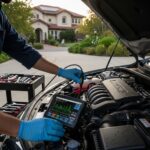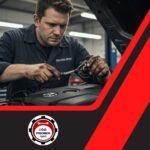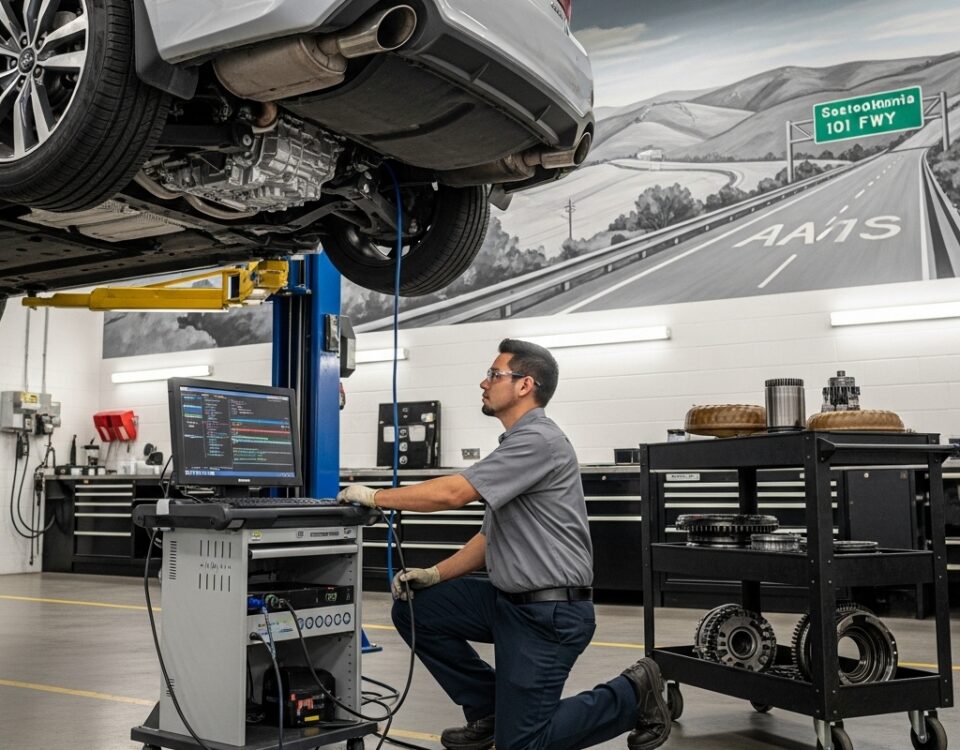
Car Repair For Engine Diagnostics In Thousand Oaks California
October 5, 2025
Experience Premium Care with a Trusted Mercedes Benz Mechanic
October 6, 2025For drivers who prefer a more connected experience, a manual transmission transforms every Thousand Oaks errand and weekend drive into something tactile and satisfying. From the gentle roll down Moorpark Road to the winding climb through the canyons above Westlake, a well-sorted manual makes each shift a small victory. When a clutch feels vague or a gear begins to resist, that connection frays—and that’s when the right local specialist becomes essential. Finding a nearby expert for dependable transmission repair is not just about fixing parts; it’s about restoring the rhythm of your daily drive and the joy of those early-morning runs when the 101 is still quiet and the air over the Conejo Valley is cool and clear.
What makes a great-shifting manual
Mechanical harmony defines a satisfying manual transmission. The clutch engages cleanly, pedal effort is predictable, the shifter finds gates without drama, and synchros match gear speeds so the lever glides on command. When that chemistry is right, driving through Thousand Oaks feels effortless—right turns onto Hillcrest, merging near Hampshire Road, and easing into parking at The Oaks all stack up into a seamless flow. But even slight deviations can spoil the experience: a spongy pedal, a notchy 2–3 shift when cold, or a grind when downshifting to second as you approach a light on Thousand Oaks Boulevard. Those symptoms are clues that, with careful diagnosis, point to solutions both simple and precise.
Common manual transmission symptoms
Manual drivers are finely tuned to feel. They notice when engagement moves higher in the pedal travel, when the shifter refuses a quick gate change on a warm afternoon, or when a faint whine rises with road speed. Grinding on fast 2–3 upshifts may suggest synchro wear; chatter when starting on an incline in Newbury Park can hint at clutch surface issues; and a pedal that doesn’t return cleanly might indicate hydraulic concerns. Because these systems interact, the right test ride and inspection can isolate the component responsible rather than assuming a one-size fix.
Local roads as diagnostic tools
Thousand Oaks offers ideal test conditions for manual transmissions. Early in the day, a cold-start drive around Conejo School Road reveals how the box behaves before temperatures stabilize. A stretch along the 101 assesses noise and vibration at steady speed. The canyons off Westlake Boulevard—especially the gentle climbs—help evaluate clutch bite, rev-matching behavior, and high-load upshifts. Returning through city streets allows for repeated low-speed downshifts to examine synchro health. A skilled specialist uses this loop to turn your impressions into data, then uses that data to craft a targeted plan.
Clutch, hydraulics, and linkage—working as one
Your clutch is more than a disc and pressure plate. The release bearing, pilot bearing, slave and master cylinders, lines, and even the pedal box geometry influence engagement. Linkage and bushings determine how the shifter feels and whether gears align consistently. So when a driver describes a vague pedal or an inconsistent gate, an expert examines the whole chain from pedal to input shaft. Sometimes a small hydraulic leak or a worn bushing is the culprit; other times, clutch wear or flywheel condition calls for a deeper solution. The point is precision: fix what’s wrong, verify what’s right, and return the whole system to balance.
Why fluid choice matters for manuals
Fluid is often overlooked in manual gearboxes, yet it is crucial for synchro performance and long-term health. The correct specification—viscosity, additives, friction characteristics—helps synchros match speeds and reduces wear. Over time, heat from stop-and-go driving along Thousand Oaks Boulevard or sustained high-speed runs on the 101 can break down these properties. A specialist will confirm the correct fluid for your unit, inspect for contamination, and verify that level and condition support crisp, reliable shifts across a range of temperatures.
Driving technique and longevity
Good technique makes a measurable difference. Fully depress the clutch at every shift, pause momentarily when selecting reverse, and avoid resting your hand on the shifter, which can preload components. When climbing the Conejo Grade, matching revs on downshifts reduces stress on the drivetrain and provides smoother control. On warm afternoons, be patient after cold starts; let the fluid come up to temperature before demanding quick, high-RPM changes. These habits aren’t about babying your car—they’re about respecting the mechanical conversation you have with it every day.
The value of a local specialist
Manual transmissions reward attention to detail. A local expert who understands our roads, our temperatures, and our traffic patterns can duplicate the exact scenario where your symptom appears. That familiarity leads to faster, more accurate diagnosis and more satisfying results. It also makes follow-up easy. If a small adjustment is needed after a clutch service or a shifter refinement, you can stop by without rearranging your life, and a quick loop through familiar streets will confirm that everything feels right.
Midway reminder: listen to your instincts
If you’re reading this and picturing a stubborn third gear or a clutch that slips on hills near Lynn Road, take that instinct seriously. Make a note of speeds, temperatures, and specific spots where the issue appears. Then reach out to a nearby shop that understands the manual-driver mindset. When you’re ready for answers, schedule precise, local transmission repair so a specialist can translate your impressions into a plan that restores the shift feel you love.
Parts quality and setup precision
Great results come from more than high-quality parts; they come from careful setup. Clutch torque capacity should match your engine and driving style, and the release system needs correct geometry for predictable engagement. Shifter bushings and mounts should be renewed carefully to avoid introducing new play. A seasoned technician will also road-test after service, fine-tuning feel while components bed in. This attention to detail separates an acceptable outcome from a truly satisfying one.
When to consider a broader refresh
Not every grind or gear pop-out demands a comprehensive rebuild. However, if multiple symptoms converge—synchro wear across gears, bearing noise that scales with road speed, and clutch slippage under load—a broader plan can restore the gearbox to a cohesive whole. The decision should be grounded in what you feel, what testing confirms, and how long you plan to keep the car. Many Thousand Oaks drivers keep their manuals for the long haul, enjoying canyon mornings and calm evening drives; for them, a holistic refresh can be a smart move.
Shifter feel: the finishing touch
The best manual cars deliver a distinct, confident gate. Achieving that means renewing worn bushings, adjusting cables or linkages, and ensuring mounts control movement without adding harshness. The payoff is everyday delight: rolling along Thousand Oaks Boulevard, slipping into second at a light, and feeling the lever click home with intent. That sensation is as much a part of your car’s personality as its exhaust note, and a specialist treats it with the respect it deserves.
Frequently asked questions
Why does my manual grind only when shifting quickly?
Fast shifts demand more from synchros. If they’re worn or the fluid’s friction properties have degraded, quick changes expose the weakness first. A targeted inspection will assess synchro health, linkage, clutch release, and fluid condition to pinpoint the cause.
How do I know if my clutch is slipping?
Engine revs rise without a matching increase in road speed, especially under load or during highway merges. You might also notice an acrid smell after a hill start. A road test up a mild grade near the 23 can confirm slippage and guide the next steps.
Can hydraulic issues mimic clutch wear?
Yes. Air in the line, a failing master or slave cylinder, or a small leak can change pedal travel and engagement point. These issues can feel like clutch wear, which is why a systematic check of the entire release system is essential.
Is it normal for first and second to feel notchy when cold?
Some notchiness when cold can be normal, but it should improve as the transmission warms. Persistent or worsening resistance may indicate fluid concerns, linkage wear, or early synchro issues. A specialist can tell the difference with a brief test drive.
Will new bushings make a big difference?
Often, yes. Worn bushings introduce play and inconsistency. Renewing them tightens the shifter’s path and can transform the feel of every gear change, especially when combined with correct fluid and linkage adjustment.
How should I break in a new clutch?
Follow your technician’s guidance, but a general rule is to vary load and avoid aggressive launches for the initial bedding period. Gentle driving around Thousand Oaks city streets allows surfaces to mate properly, setting the stage for long-term performance.
Do I need specialized parts for canyon driving?
Not necessarily. What you need is a setup matched to your car and style. For drivers who enjoy Decker Canyon or Mulholland, consistent pedal feel and predictable engagement are priorities. A well-chosen clutch, correct hydraulics, and sound mounts usually deliver exactly that.
Ready to restore your shift feel
If you miss the crisp, confident engagement your manual once delivered, don’t wait for small quirks to become big frustrations. Partner with a local specialist who understands the nuances of manual transmissions and the unique rhythms of our Thousand Oaks roads. Your daily drive and weekend loops will feel better for it. Reach out now for expert transmission repair and get back to the tactile, engaging experience that drew you to a manual in the first place.





